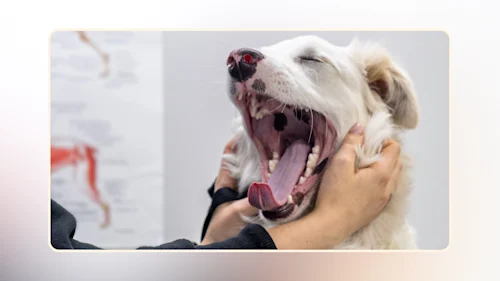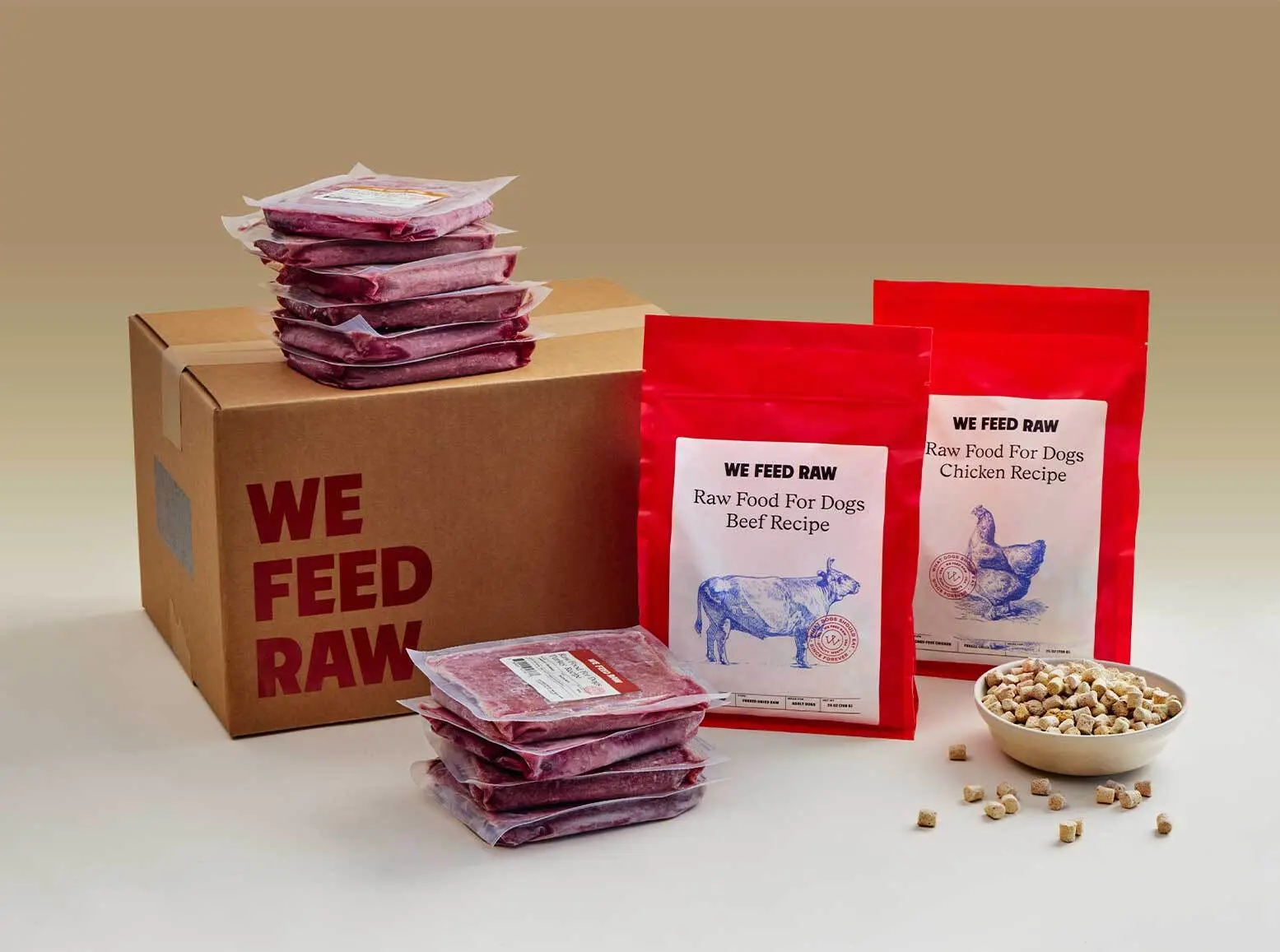
How a Raw Diet Is Better for Dog Dental Care
Table of Contents
Did you know that 80% of dogs and 70% of cats develop some type of oral disease by the age of 3? February is National Pet Dental Health Month—the perfect time to talk about the consequences of poor dog dental care, symptoms of dental disease in dogs, and why a raw diet is better for your dog’s teeth than kibble.
How Does Diet Impact Pet Dental Health?
Kibble manufacturers like to say that dry food is better for dogs’ teeth because the act of chewing the crunchy bits helps scrape plaque and tartar off. The reality is that a dog eating kibble to have clean teeth makes about as much sense as a human eating crackers to clean their teeth.
In fact, dog saliva doesn’t contain the enzyme amylase to break down the starch in kibble. Instead, the bacteria in your dog’s mouth feed on the carbohydrates and sugars in starch and form plaque and tartar buildup. This buildup attracts even more bacteria, and when your dog’s immune system tries to fight back against the excessive bacteria in their mouth, they get inflammation or gingivitis—the start of periodontal disease.
On the other hand, raw dog food is low in starch and contains natural live enzymes and good bacteria that help prevent tartar and plaque buildup. Dogs that eat whole raw meaty bones (chicken backs, turkey necks) and recreational bones (beef ribs, beef kneecaps) benefit from the abrasive action of the bone scraping plaque and tartar off their teeth while they chew on it. This is one of the reasons raw meaty bones and recreational bones are often affectionately referred to as "nature's toothbrush."
How much of an impact does diet have on dog teeth cleaning? One study showed that raw-fed dogs with healthy teeth and gums who were switched to kibble developed yellow teeth, stinky breath, and sore bleeding gums within only 17 days.
How Poor Oral Hygiene Affects Dogs
The consequences of poor oral hygiene are much worse than your dog simply having bad breath. Bacteria trapped under the gumline can migrate throughout your dog’s body and cause a whole lot of trouble. Here are some of the most common problems that can be caused by dental disease in dogs.
Reduced Appetite and Lost Weight
If you’ve ever needed to have a root canal or a tooth pulled, you understand how much it can hurt to eat when you’re experiencing dental pain. Dogs with dental problems may become reluctant to eat, leading to weight loss. Dental disease that causes problems with the kidneys, heart, or liver could also contribute to weight loss.
Gum Inflammation
The bacteria associated with plaque accumulates under the gumline and releases toxins that damage surrounding tissues. This inflammation of the gums is known as gingivitis and makes the gums look extra puffy and red. The gums may bleed when touched.
Liver and Kidney Disease
Oral inflammation lets bacteria from the mouth enter the bloodstream and travel to other organs, especially the kidneys and liver. In fact, cases of untreated canine periodontal disease are well-documented to cause organ infection and even failure.
Jaw Fracture
The inflammation associated with poor dog dental care also commonly causes periodontitis—loss of the structural tissues around the teeth. Eventually, this can lead to weakened or even fractured tooth sockets or jaw bones.
Heart Disease
Bacteria that enter the bloodstream from underneath inflamed gums can reach the heart and cause an inflammatory condition called endocarditis. Dental disease has been shown to put dogs at increased risk of congestive heart failure, which can become fatal.
Symptoms of Dental Disease in Dogs
Symptoms of periodontal disease in dogs include:
•Bad breath
•Inflamed or bleeding gums
•Excessive drooling
•Missing or loose teeth
•Yellow or brown teeth
•Weight loss
•Blood on chew toys or in water bowl
•Favoring one side of the mouth when chewing
•Bloody or “ropey” saliva
•Irritability
•Reduced appetite
How to Clean Dogs’ Teeth
If your pup already has plaque and tartar buildup, they may need dog teeth cleaning done by the vet while they’re under anesthesia. While anesthesia-free dental clinics have become popular, those cleanings don’t get under the gumline, so they don’t solve the entire problem.
Once your dog has their teeth cleaned by the vet, starting them on a raw diet can help keep the “doggie dentist” away for far longer than a kibble diet.
Ways to Strengthen Your Dog’s Teeth
While switching your dog to a raw diet can go a long way toward improving their dental health, there are lots of other ways you can improve your dog’s oral health and, as a result, their overall health. Here are some of the best ways to strengthen your dog’s teeth.
Brushing Your Dog’s Teeth
You likely brush your own teeth every day (or are at least aware that you should), so it shouldn’t come as a surprise that brushing your dog’s teeth every day can provide the same benefits.
To be clear, you should NEVER use human toothpaste to brush your pup’s teeth, since it contains ingredients that are toxic for dogs.
There are plenty of toothpaste brands made exclusively for pets, with flavors like poultry and peanut butter to appeal to dog taste buds. Alternatively, you can use MCT oil on the toothbrush. The medium-chain fatty acids (MCTs) in the oil have antimicrobial properties.
Ultimately, though, it’s the act of using a toothbrush that helps remove plaque biofilm, so you should incorporate toothbrushing somewhere into your dog’s daily routine.
Prebiotics and Probiotics
Not only are oral probiotics excellent for improving your dog’s gut health, but you can also rub them on your dog’s gums to help battle bad bacteria, reduce inflammation, and freshen breath.
Prebiotics—soluble fibers—are the primary food source for probiotics, making them an important addition to not only your dog’s diet but also their dental health.
You can make your dog a pre- and probiotic slurry by mixing together soluble fiber (like garlic, blended dandelion greens, or a medicinal mushroom supplement), a probiotic supplement, and bone broth. When your dog drinks the mixture, it will coat their teeth to help fight plaque buildup and inflammation.
Fatty Acids
Omega-3 fatty acids are a critical part of your dog’s diet. Not only do they help support brain, kidney, heart, and joint health, but they also support periodontal tissues and oral health.
Antioxidants
Free-radical damage to the body’s tissues and cells is called oxidative stress, and it’s been linked with oral bacteria that leads to periodontal disease. Antioxidants help prevent oxidative stress, so green leafy vegetables, berries, and other antioxidant-rich foods should be incorporated into your dog’s diet.
Raw Meaty Bones
While cooked bones can splinter when chewed, risking damage to your dog’s intestinal tract, raw meaty bones are softer and therefore safer. Chewing on raw meaty bones helps naturally scrape plaque off your dog’s teeth, massages the gums, and helps prevent boredom, which is a leading cause of destructive behaviors.
Make the Switch to Raw Dog Food
Adding some raw to your dog’s diet could provide dental benefits, even if you can’t afford to feed a fully raw diet. Learn more about why We Feed Raw is the perfect choice for your pup or take our quiz now to get started on a We Feed Raw meal plan.

Our Meals Change Lives.
(Theirs + Yours.)
See health improvements from our raw meals in as little as 1 week.
